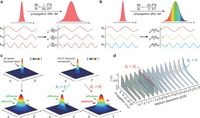In a groundbreaking study, researchers have introduced the concept of ‘two-dimensional space-time duality’, a pivotal advancement in the field of optics that establishes a foundational relationship between spatially structured light and spatiotemporal (ST) beams. This innovative framework not only enhances our understanding of light manipulation but also enables the precise generation of ST wavepackets with remarkable fidelity, a promise for future technological applications in various wave-based systems.
The research, led by Wei Chen and colleagues at several leading institutions, was published on March 21, 2025, in Nature Communications. The team revealed that by manipulating the balance between the diffraction of light beams and the dispersion of short optical pulses, they could effectively guide the dynamics of ST wavepackets. They reported crafting ST beams with an impressive fidelity exceeding 97%, thus demonstrating the efficacy of their novel approach.
Historically, optics has evolved significantly, particularly since Einstein’s theory of relativity reshaped humanity’s understanding of space and time. A major frontier has emerged through the study of light’s properties, especially in how it behaves under varying conditions. Prior to this breakthrough, research faced challenges due to the lack of a universal framework for analyzing and generating ST wavepackets. This limitation significantly hindered advancements in the field. Consequently, the proposal of a unified approach using the concept of two-dimensional space-time duality could usher in a new era of optical exploration.
The researchers highlighted that breaking the exact balance between paraxial diffraction and narrow-band dispersion is crucial to manipulating ST wavepacket dynamics. This insight led to their introduction of a versatile complex-amplitude modulation strategy, which simplifies the generation of ST beams and allows for tailored wavepackets that meet specific experimental requirements.
Practical demonstrations included the generation of various types of ST beams. For instance, they successfully synthesized 2D ST Airy wavepackets, which were notable for their properties. These wavepackets had a spatial width of approximately 90 µm and a temporal width of around 250 fs. Additionally, their projections along the spatial axis resembled a standard one-dimensional spatial Airy beam with a main lobe width of roughly 160 µm.
The team also reported high fidelity in generating STB vortices, with a fidelity rate of 97.5%. These vortices, characterized by their unique transverse orbital angular momentum (OAM), represent a significant visual advancement, demonstrating how closely experimental results matched theoretical expectations. The spatial spectral width of these vortices measured around 111 rad/mm, coupled with a wavelength width of approximately 11.2 nm, attesting to the precision of the modulation techniques employed.
Moreover, the team ventured into the realm of ST Laguerre-Gaussian (STLG) vortices, achieving a theoretical fidelity of 98.4% while producing the desired outputs through the new modulation strategy. These STLG vortices exhibited intricate features and were characterized by their radial and angular mode numbers, highlighting the rich complexity available through this framework.
Theoretically, the study of ST wavepackets revealed further opportunities, with the framework establishing an exact duality-based correspondence between ST beams and their spatial counterparts. This correspondence not only enriches the understanding of ST phenomena but also implies the discovery of a myriad of ST wavepackets awaiting exploration, suggesting that we have only begun to tap into the potential of these advanced optical concepts. Technologically, such advancements could significantly enhance applications in quantum optics, telecommunications, and other fields relying on sophisticated light manipulation.
The researchers also considered the constraints faced during modulation, where factors such as insertion loss and the efficiency of spatial light modulators could impede high fidelity generation. The study was performed under conditions that naturally exhibit near-zero dispersion—ambitiously positioning itself within the complexities of optical physics and paving the way for future work.
In conclusion, this research serves as an exemplary blend of theoretical and practical advancements in optical science. The once-esoteric concepts of light manipulation and wave packet generation have reached a new level of clarity and capability. Future investigations promise to unlock even more capabilities in generating diverse ST wavepackets, ultimately advancing our manipulation and understanding of light. The potential applications are vast and may span across diverse fields, from quantum information technologies to revolutionary developments in optical engineering.




